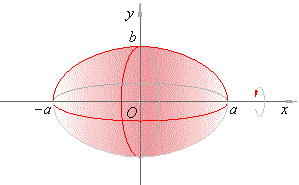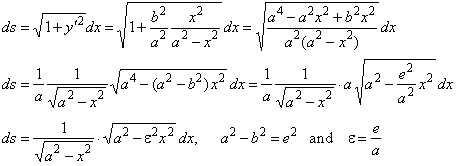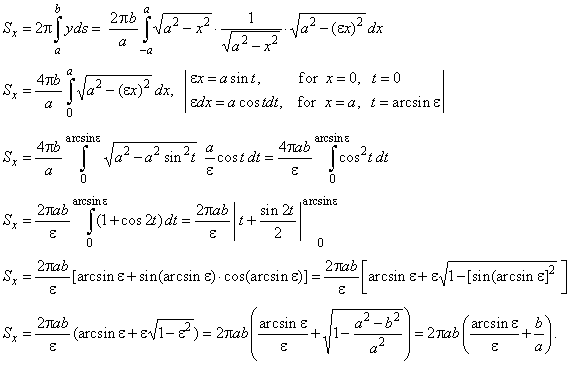|
| Integral
calculus |
|
|
Applications
of the definite integral
|
 The
surface area of a solid of revolution
The
surface area of a solid of revolution
|
|
The
lateral surface area of a cone
|
|
The surface area of a spherical
cap
|
|
The surface area of an
ellipsoid
|
|
|
|
|
|
|
|
|
|
|
|
The
surface area of a solid of revolution
|
|
The surface area generated by the segment of a curve y
= f (x)
between x
= a and
y
= b rotating around
the
x-axis,
is shown in the left figure below.
|
|
Since the infinitesimal surface area
of an element of the integration,
|

|
|
where
y is the radius
and ds is the arc length of the element of the curve, then
|
|
|
|
The surface area generated by the segment of a curve
x = g
(y) between
y
= c and y
= d rotating around
the
y-axis,
is shown in the right figure above.
|
|
|
|
The surface area generated by rotating
a parametric curve about the
x-axis,
|

|
|
|
|
The
lateral surface area of a cone
|
|
Example: Find the
lateral surface area of a
right circular cone generated by the line (segment) through
the
origin and the point (h,
r), where h
denotes the height of the cone and r
is the radius of its base, revolving around the
x-axis,
as shows the below figure.
|
|
Solution: The equation of the
generating line
|
|
|
|
|
|
The surface area of a spherical
cap
|
|
Example: Find the surface area of a
spherical cap, with the height h,
generated by the portion of the right
semicircle rotating around
the y-axis,
as
is shown in the below figure.
|
|
Solution: The equation of the right
semicircle
|
|
|
|
|
|
The surface area of an
ellipsoid
|
|
Example: Find the surface area of an
ellipsoid generated by the ellipse b2x2
+ a2y2 = a2b2
rotating around
the
x-axis,
as shows the below figure.
|

|
|
Solution: The equation of the upper
half of the ellipse and its derivative
|

|
|
the arc length of the element of the
curve
|

|
|
where, e
and e
denote the linear and the numerical eccentricity respectively.
Therefore,
|

|
|
|
|
|
|
|
|
|
|
|
|
|
|
|
|
|
|
|
| Calculus contents
F |
|
|
 |
|
| Copyright
© 2004 - 2020, Nabla Ltd. All rights reserved. |